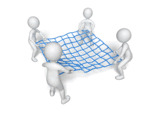 The growing debate about the safety of our health care systems is gaining momentum.
The growing debate about the safety of our health care systems is gaining momentum.
This is not just a UK phenomenon.
The same question was being asked 10 years ago across the pond by many people – perhaps the most familiar name is Don Berwick.
The term Improvement Science has been buzzing around for a long time. This is a global – not just a local challenge.
Seeing the shameful reality in black-and-white [the Francis Report] is a nasty shock to everyone. There are no winners here. Our blissful ignorance is gone. Painful awareness has arrived.
The usual emotional reaction to being shoved from blissful ignorance into painful awareness is characteristic; and it does not matter if it is discovering horse in your beef pie or hearing of 1200 avoidable deaths in a UK hospital.
Our emotional reaction is a predictable sequence that goes something like:
Shock => Denial => Anger =>Bargaining =>Depression =>Acceptance
=> Resolution.
It is the psychological healing process that is called the grief reaction and it is a normal part of the human psyche. We all do it. And we do it both individually and collectively. I remember well the global grief reactions that followed the sudden explosion of Challenger; the sudden death of Princess Diana; and the sudden collapse of the Twin Towers.
Fortunately such avoidable tragedies are uncommon.
The same chain-reaction happens to a lesser degree in any sudden change. We grieve the loss of our old way of thinking – we mourn the passing away our comfortable rhetoric that has been rudely and suddenly disproved by harsh reality. This is the Nerve Curve. And learning to ride it safely is a critical-to-survival life skill. Especially in turbulent times.
The UK population has suffered two psychological shocks in recent weeks – the discovery of horse in the beef pie and the fuller public disclosure of the story behind the 1000’s of avoidable deaths in one of our Trust hospitals. Both are now escalating and the finger of blame is pointing squarely at a common cause: the money-tail-wagging-the-safety-dog.
So what will happen next? The Wall of Denial has been dynamited with hard evidence. We are now into the Collective Anger phase.
First there will be widespread righteous indignation and a strong desire to blame, to hunt down the evil ones, and to crucify the responsible and accountable. Partly as punishment, partly as a lesson to others, and partly to prevent them doing harm again. Uncontrolled anger is dangerous especially when there is a lethal weapon to hand. The more controlled, action-oriented and future-focused will want to do something about it. Now! There will be rallies, and soap-boxes, and megaphones. The We-Told-You-So brigade will get shoved aside and trampled in the rush to do something – ANYTHING. Conferences will be hastily arranged and those most fearful for their reputations and jobs will cough up the cash and clear their diaries. They will be expected to be there. They will be. Desperately looking for answers. Anxiously seeking credible leaders. And the snake-oil salesmen will have a bonanza! The calmer, more reflective, phlegmatic, academic types will call for more money for more research so that we can fully analyse and fully understand the problem before we do anything.
And while the noisy bargaining for more cash keeps everyone busy the harm will continue to happen.
Eventually the message will sink in as the majority accept that there is no way to change the past; that we cannot cling to what is out-of-date thinking; and that all of our new-reality-avoiding tactics are fruitless. And we are forced to accept that there is no more cash. Now we are in danger of becoming helpless and hopeless, slipping into depression, and then into despair. We are at risk of giving up and letting ourselves wallow and drown in self-pity. This is a dangerous phase. Depression is understandable but it is avoidable because there is always something than can be done. We can always ask the elephant-in-the-room questions. Inside we usually know the answers.
We accept the new reality; we accept that we cannot change the past, we accept that we have some learning to do; we accept that we have to adjust; and we accept that all of us can do something.
Now we have reached the most important stage – resolution. This is the test of our resolve. Are we all-talk or can we convert talk-to-walk?
 We can all ask ourselves one question: “What can I do to help?”
We can all ask ourselves one question: “What can I do to help?”
I have asked myself that question and my first answer was “As a system designer I can help by looking at this challenge as a design assignment and describe what I see “.
Design starts with the intended outcome, the vision, the goal, the objective, the specification, the target.
The design goal is: Significant reduction in avoidable harm in the NHS, quickly, and at no extra cost.
[Please note that a design goal is a “what we get” not a “what we do”. It is a purpose and not just a process.]
Now we can invite, gather, dream-up, brain-storm any number of design options and then we can consider logically and rationally how well they might meet our design goal.
What are some of the design options on the table?
Design Option 1. Create a cadre of hospital inspectors.
Nope – that will take time and money and inspection alone does not guarantee better outcomes. We have enough evidence of that.
Design Option 2. Get lots more PhDs funded, do high quality academic research, write papers, publish them and hope the evidence is put into practice.
Nope – that will take time and money too and publication alone does not guarantee adoption of the lessons and delivery of better outcomes. We have enough evidence of that too. What is proven to be efficacious in a research trial is not necessarily effective, practical or affordable in reality.
Design Option 3. Put together conferences and courses to teach/train a new generation of competent healthcare improvement practitioners.
Maybe – it has the potential to deliver the outcome but it too will take time and money. We have been doing conferences and courses for decades – they are not very cost-effective. The Internet may have changed things though.
Design Option 4. All of the above plus broadcast via the Internet the current pragmatic know-how of the basics of safe system design to everyone in the NHS so that they know what is possible and they know how to get started.
Promising – it has the greatest potential to deliver the required outcome, a broadcast will cost nothing and it can start working immediately.
OK – Option 4 it is – here we go …
The Basics of How To Design a Safe System
Definition 1: Safe means free of risk of harm.
Definition 2: Harm is the result of hazards combining with risks.
There are two components to safe system design – the people stuff and the process stuff.
For example a busy main road is designed to facilitate the transport of stuff from A to B. It also represents a hazard – the potential for harm. If the vehicles bump into each other or other things then harm will result. So a lot of the design of the vehicles and the roads is about reducing the risk of bumps or mitigating the effects (e.g. seat-belts).
The risk is multi-factorial. If you drive at high speed, under the influence of recreational drugs, at night, on an icy road then the probability of having a bump is high. If you step into a busy road without looking then the risk of getting bumped into is high too.
So the path to better safety is to eliminate as many hazards as possible and to reduce the risks as much as possible. And we have to do that without unintentionally creating more hazards, higher risks, excessive delays and higher costs.
So how is this done outside healthcare?
One tried-and-tested method for designing safer processes is called FMEA – Failure Modes and Effects Analysis.
Now that sounds really nerdy and it is. It is an attention-to-detail exercise that will make your brain ache and your eyes bleed. But it works – so it is worthwhile learning the basic principles.
For the people part there is the whole body of Human Factors Research to access. This is also a bit nerdy for us hands-on oily-rag pragmatists so if you want something more practical immediately then have a go with The 4N Chart and the Niggle-o-Gram (which is a form of emotional FMEA). This short summary is also free to download, read, print, copy, share, discuss and use.
OK – I am off to design and build something else – an online course for teaching safety-by-design.
What are you going to do to help improve safety in the NHS?
